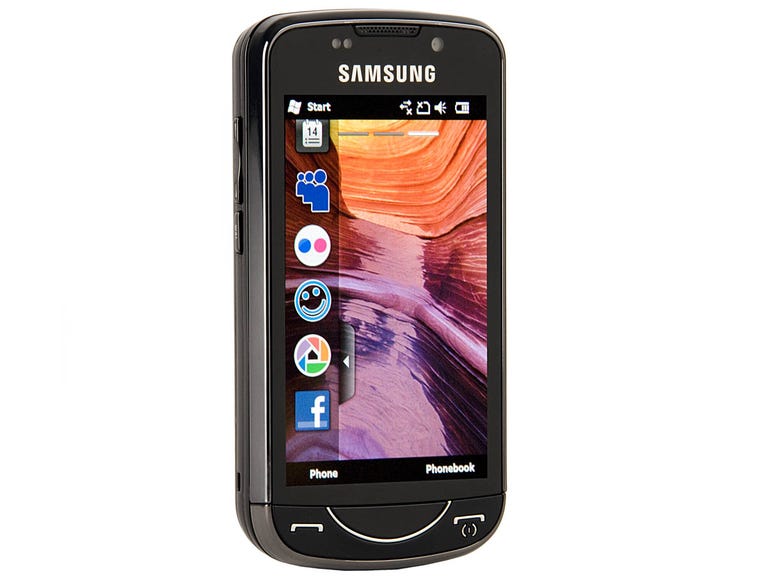 Why You Can Trust CNET
Why You Can Trust CNET Samsung Omnia Pro B7610 review: Samsung Omnia Pro B7610
The Omnia Pro B7610 doesn't feel like the freshest loaf to emerge from the smart-phone oven, due to its resistive touchscreen and Windows Mobile 6.5 operating system. But its slide-out Qwerty keyboard is easy to use and the phone's packed with pre-installed apps
The Samsung Omnia Pro B7610 is a Windows Mobile smart phone with a slide-out Qwerty keyboard. If it had arrived a year ago -- or even six months ago -- that might have been enough to score it more points with us. But its dated operating system and resistive touchscreen conspire to make it feel like too little, too late, despite its overload of features.
The Good
The Bad
The Bottom Line
The Omnia Pro B7610 is available SIM-free for around £370, and you can also get it for free on a £35-a-month contract if you look online.
Out the Windows
The Omnia Pro uses the Windows Mobile 6.5 operating system, which was
feeling pretty dated even before Microsoft announced that it had a whole new
version in the oven -- Windows Phone
7 Series -- which starts from scratch. Now that even Microsoft has admitted
that Windows Mobile 6.5 is rubbish, we don't feel that we can recommend a
phone that runs on it.
Samsung's skinned Windows Mobile with a better-looking, more user-friendly home screen. In fact, it's done it twice. There are two home-screen set-ups -- accessible by pressing a button on the side of the phone -- one for work and one for play. The work version is a sober-looking list of notifications that wouldn't look out of place on a Nokia E72. The play version sports the TouchWiz user interface familiar from other Samsung phones.
The presence of TouchWiz means there's a whole heap of widgets that you can drag onto the screen from a dock down the side. We're not big fans of this design for two reasons -- the widgets are easy to move accidentally when you're swiping the touchscreen, and the widgets themselves are pretty basic. The Facebook widget is just a link to the Facebook Web site, rather than a live display of your status updates, for example.

Samsung's made a good stab at making Windows Mobile easier to use, but, unfortunately, neither home-screen set-up works well enough -- transitions are delayed, the widgets update too slowly, and the position of the widgets gets messed up when you switch from portrait to landscape mode.
Sticky screen
The Omnia Pro also has a resistive touchscreen, which means you have to use
a fingernail or apply pressure to get it to register your inputs. There's also a stylus included in the
side of the case. We found the touchscreen unresponsive and difficult to use. Combined with the small icons employed in many parts of the operating system, the Omnia Pro can be very irritating to use at times.
You can, however, often choose to use the full Qwerty keyboard instead of the touchscreen, and the keys are big and easy to press. That will earn the Omnia Pro extra points among business users and social-networking types who like to do plenty of typing.
Information overload
Samsung hasn't skimped on features with the Omnia Pro, both in terms of the hardware and software. There are heaps of apps pre-installed. For example, speedy Opera
Mobile is the default browser, instead of Internet Explorer, which is a welcome
swap.
There's a 5-megapixel camera on-board, with an LED photo light. We found the camera slightly slow to launch and capture shots, but, if you can get your subjects to sit still, there are tonnes of camera options to help you get the photo you want.
Having an abundance of features can be more trouble than it's worth when they're not easy to find and use, however. We appreciated the customisable menu that Samsung's added to help you organise the feature bounty, but there's also a default Windows start menu, so it just leads to yet more icon overload.
Conclusion
The Samsung Omnia Pro B7610 is a perfect example of a phone that has all
the right features on paper but disappoints in practice. The heaps of apps and widgets
all add up to overkill without a smooth, easy-to-use interface. The keyboard is
convenient and you won't be short on features, but the sluggish resistive
touchscreen and dated operating system hold this phone back.
If you're dying for a touchscreen Windows Mobile phone, the HTC HD2 is a well-designed alternative, although it doesn't have a Qwerty keyboard. For keyboard fans, the Motorola Milestone, Motorola Dext and Palm Pre all offer more phone fun than the Omnia Pro, but they don't run Windows Mobile.
Edited by Charles Kloet
